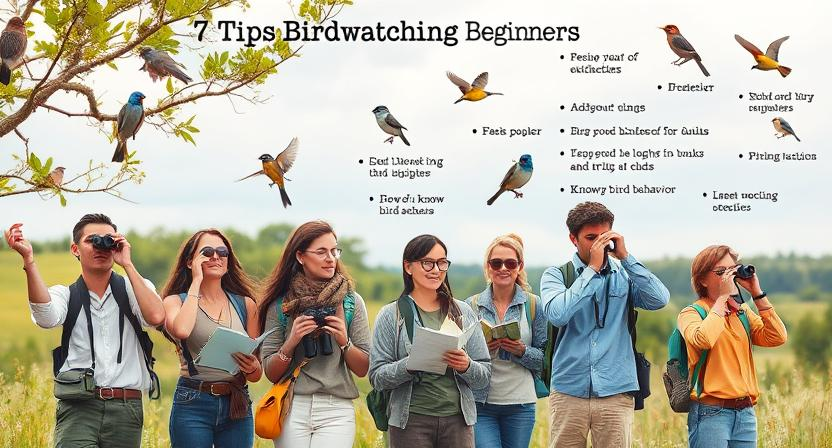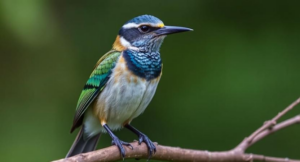
7 Tips for Birdwatching Beginners
Birdwatching Basics

Birdwatching is a popular hobby that allows individuals to connect with nature and observe the fascinating world of birds. For beginners, it is essential to understand the basics of birdwatching in order to have a rewarding experience.
To start with, it is important to invest in a good pair of binoculars. These will help you observe birds from a distance without disturbing their natural habitat. Additionally, a field guide is a valuable tool for identifying different bird species, providing detailed information about their appearance, habitat, and behavior.
Once you have your equipment ready, finding the perfect spot is crucial. Birds can be found in a variety of habitats, ranging from forests and wetlands to parks and gardens. It is recommended to visit areas known for their rich bird populations, as this increases the chances of spotting a diverse range of species. Patience is key while birdwatching, as it may take time for the birds to come into view. It is important to remain still and quiet, allowing the birds to feel comfortable and continue their daily activities without interruption.
What You Need to Know Before Starting
Birdwatching is a fascinating and rewarding hobby that allows you to connect with nature and observe the beauty of birds in their natural habitats. Before embarking on your birdwatching adventure, there are a few essential things you need to know. Firstly, it’s important to understand that birdwatching requires patience and a keen eye. Birds can be elusive and blend into their surroundings, so having a sharp awareness of your surroundings and being able to spot movements and subtle details is crucial.
Another aspect to consider is that birdwatching requires some level of physical fitness and stamina. This hobby often involves walking through various terrains, such as forests, wetlands, and meadows, to spot different bird species. So, it’s advisable to be prepared for long walks and potentially challenging conditions. Additionally, having a basic knowledge of weather conditions and how they affect bird behavior can greatly enhance your birdwatching experience.
Choosing the Right Equipment

Birdwatching is an activity that requires the use of specific equipment to enhance and optimize the experience. One essential item is a pair of binoculars, which allows birdwatchers to observe birds from a distance without disturbing their natural behavior. When selecting binoculars, it is important to consider factors such as magnification power, lens quality, and weight. Opting for a magnification between 7x and 10x is recommended for versatility and ease of use. Additionally, choosing binoculars with coated lenses can enhance image clarity and brightness, while considering the weight can ensure comfortable long-term use.
Another crucial piece of equipment for birdwatchers is a field guide. Field guides provide detailed information about different bird species, including their appearance, habitat, behaviors, and calls. They serve as a handy reference for identification and can greatly enhance the overall birdwatching experience. When choosing a field guide, consider the region where you will be birdwatching to ensure it covers the common species found in that area. Additionally, selecting a field guide with clear, detailed illustrations or photographs can aid in accurate identification.
Finding the Perfect Spot
Finding the perfect spot is an essential aspect of successful birdwatching. It involves carefully selecting a location that offers optimal opportunities for observing a diverse range of bird species in their natural habitats. When searching for a suitable spot, it is important to consider factors such as habitat diversity, accessibility, and the presence of food sources.
One of the key elements to consider when finding the perfect spot is habitat diversity. Different bird species prefer different types of habitats, such as forests, wetlands, or grasslands. By choosing a location with a variety of these habitats in close proximity, you increase your chances of encountering a greater number of bird species. Additionally, look for spots that offer a mixture of vegetation types, including both dense cover for shy birds and open areas for species that prefer more visibility.
Understanding Bird Behavior

Bird behavior plays a crucial role in the world of birdwatching. By understanding how birds behave, enthusiasts can anticipate their movements and increase their chances of spotting different species. One important aspect to consider is feeding behavior. Some birds are seed-eaters, while others prefer insects or nectar. The time of day can also influence their activity, with many birds becoming more active during the early morning and late afternoon. Observing their feeding patterns can provide valuable insights into their preferences and help birdwatchers plan their outings accordingly.
In addition to feeding behavior, social interactions among birds are another fascinating aspect to observe. Many bird species exhibit complex social structures, forming flocks or pairs. Some birds are highly territorial, defending their territories and engaging in vocal or physical displays to ward off intruders. Understanding these social dynamics can be key to identifying certain species and predicting where they are likely to be found. By carefully observing their interactions, birdwatchers can unravel the intricate relationships among different bird species and enjoy a deeper appreciation for their behavior.
Identifying Common Bird Species
Birdwatching is a popular hobby enjoyed by people all over the world. One of the essential skills for birdwatchers is the ability to identify common bird species in their area. Being able to recognize different species of birds allows birdwatchers to document and share their sightings accurately.
There are various ways to identify common bird species. One approach is to observe the physical characteristics of the birds, such as their size, shape, and coloration. Paying attention to specific features, such as beak shape, wing patterns, or tail length, can help in distinguishing between similar-looking species. Another helpful aspect is understanding the behavior and habitat preferences of the birds. Some birds prefer to stay in open fields, while others are commonly found near bodies of water or dense forests. By familiarizing themselves with these patterns, birdwatchers can narrow down the possibilities when trying to identify a particular bird species.
Tips for Improving Your Observation Skills

Observation skills are crucial for any birdwatcher looking to enhance their experiences in the field. One way to improve your observation skills is to practice patience. Birds can be elusive creatures, and it may take some time before you spot one. Instead of rushing, take your time and allow your eyes to scan the surroundings. Look for movement, listen for distinctive calls, and pay attention to any rustling in the leaves – these can all be indicators of nearby birds.
Another helpful tip is to utilize binoculars effectively. When using binoculars, keep your focus on a specific area and slowly scan from left to right or vice versa. This method ensures that you cover the entire field of view and allows you to spot birds that might otherwise go unnoticed. It’s also crucial to learn how to adjust the focus of your binoculars quickly to keep up with fast-moving birds. With practice, you’ll become more proficient in maximizing the potential of your binoculars and spotting even the most well-camouflaged birds.
Recording and Documenting Your Sightings
During your birdwatching expeditions, it is essential to record and document your sightings. Keeping detailed notes of your observations can help you track your progress, identify patterns, and contribute to scientific research. One of the simplest ways to record your sightings is by using a notebook or a dedicated birdwatching journal. In your entries, include relevant information such as the date, time, weather conditions, habitat, and any behavioral or physical characteristics you noticed. It is also helpful to capture any photos or videos, as these can serve as visual evidence of your discoveries and aid in species identification.
In addition to written documentation, you may want to consider using various birdwatching apps or online platforms designed for recording sightings. These digital tools offer the advantage of easy access and organization, allowing you to create comprehensive logs of your birdwatching adventures. Some apps even come with built-in bird identification guides to help you identify unfamiliar species. Furthermore, by participating in citizen science projects like eBird or iNaturalist, you can contribute your data to ongoing research while connecting with a global community of birdwatchers. Remember, the more accurate and detailed your recordings, the more valuable they become for both personal and scientific purposes.
Connecting with Other Birdwatchers

Birdwatching is a fascinating hobby that allows individuals to connect with nature and appreciate the beauty and diversity of birds. However, it can be even more enriching when you connect with other birdwatchers who share your passion. One way to connect with fellow birdwatchers is to join local birdwatching clubs or organizations. These communities are filled with individuals who have a wealth of knowledge and experience to share. By participating in club meetings, field trips, and birdwatching events, you can not only learn from others but also forge new friendships and create lasting connections with like-minded individuals.
Another way to connect with other birdwatchers is through the use of online platforms and social media. There are numerous birdwatching communities and forums where you can join discussions, ask questions, and share your own birdwatching experiences. This virtual interaction allows you to connect with birdwatchers from all over the world, learn about different bird species and their habitats, and gain insights into various birdwatching techniques. Additionally, some online platforms offer features that allow you to connect with birdwatchers in your local area, making it easier for you to plan outings and birdwatching trips together.
Conservation and Ethical Considerations
Birdwatching is a hobby that brings people closer to nature and allows them to appreciate the diverse avian population. However, it is important to consider the impact of our actions on birds and their habitats. Conservation and ethical considerations play a crucial role in ensuring that birdwatching remains a sustainable and responsible activity.
One important aspect of conservation and ethical considerations is the need to minimize disturbance to bird populations. While it is exciting to observe birds up close, getting too close or making sudden, loud movements can disrupt their behavior and breeding patterns. It is crucial to maintain a respectful distance from the birds and avoid disturbing their nests or habitats. Additionally, it is essential to be mindful of the time of year and the vulnerability of certain species during their breeding season or migration periods. By being aware of these factors, birdwatchers can contribute to the conservation and protection of bird populations.


